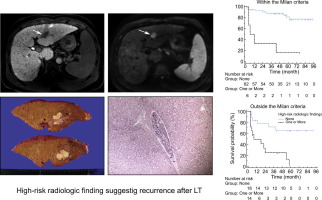当前位置:
X-MOL 学术
›
J. Hepatol.
›
论文详情
Our official English website, www.x-mol.net, welcomes your feedback! (Note: you will need to create a separate account there.)
Hepatobiliary MRI as novel selection criteria in liver transplantation for hepatocellular carcinoma
Journal of Hepatology ( IF 25.7 ) Pub Date : 2018-06-01 , DOI: 10.1016/j.jhep.2018.01.024 Ah Yeong Kim , Dong Hyun Sinn , Woo Kyoung Jeong , Young Kon Kim , Tae Wook Kang , Sang Yun Ha , Chul Keun Park , Gyu Seong Choi , Jong Man Kim , Choon Hyuck David Kwon , Jae-Won Joh , Min-Ji Kim , Insuk Sohn , Sin-Ho Jung , Seung Woon Paik , Won Jae Lee
Journal of Hepatology ( IF 25.7 ) Pub Date : 2018-06-01 , DOI: 10.1016/j.jhep.2018.01.024 Ah Yeong Kim , Dong Hyun Sinn , Woo Kyoung Jeong , Young Kon Kim , Tae Wook Kang , Sang Yun Ha , Chul Keun Park , Gyu Seong Choi , Jong Man Kim , Choon Hyuck David Kwon , Jae-Won Joh , Min-Ji Kim , Insuk Sohn , Sin-Ho Jung , Seung Woon Paik , Won Jae Lee

|
BACKGROUND & AIMS
Hepatobiliary magnetic resonance imaging (MRI) provides additional information beyond the size and number of tumours, and may have prognostic implications. We examined whether pretransplant radiological features on MRI could be used to stratify the risk of tumour recurrence after liver transplantation (LT) for hepatocellular carcinoma (HCC). METHODS
A total of 100 patients who had received a liver transplant and who had undergone preoperative gadoxetic acid-enhanced MRI, including the hepatobiliary phase (HBP), were reviewed for tumour size, number, and morphological type (e.g. nodular, nodular with perinodular extension, or confluent multinodular), satellite nodules, non-smooth tumour margins, peritumoural enhancement in arterial phase, peritumoural hypointensity on HBP, and apparent diffusion coefficients. The primary endpoint was time to recurrence. RESULTS
In a multivariable adjusted model, the presence of satellite nodules [hazard ratio (HR) 3.07; 95% confidence interval (CI) 1.14-8.24] and peritumoural hypointensity on HBP (HR 4.53; 95% CI 1.52-13.4) were identified as independent factors associated with tumour recurrence. Having either of these radiological findings was associated with a higher tumour recurrence rate (72.5% vs. 15.4% at three years, p <0.001). When patients were stratified according to the Milan criteria, the presence of these two high-risk radiological findings was associated with a higher tumour recurrence rate in both patients transplanted within the Milan criteria (66.7% vs. 11.6% at three years, p <0.001, n = 68) and those who were transplanted outside the Milan criteria (75.5% vs. 28.6% at three years, p <0.001, n = 32). CONCLUSIONS
Radiological features on preoperative hepatobiliary MRI can stratify the risk of tumour recurrence in patients who were transplanted either within or outside the Milan criteria. Therefore, hepatobiliary MRI can be a useful way to select potential candidates for LT. LAY SUMMARY
High-risk radiological findings on preoperative hepatobiliary magnetic resonance imaging (either one of the following features: satellite nodule and peritumoural hypointensity on hepatobiliary phase) were associated with a higher tumour recurrence rate in patients transplanted either within or outside the Milan criteria.
中文翻译:

肝胆 MRI 作为肝细胞癌肝移植的新选择标准
背景和目的 肝胆核磁共振成像 (MRI) 提供了超出肿瘤大小和数量的额外信息,并且可能具有预后意义。我们检查了移植前 MRI 的放射学特征是否可用于对肝细胞癌 (HCC) 肝移植 (LT) 后肿瘤复发的风险进行分层。方法 对 100 名接受肝移植术并接受了包括肝胆期 (HBP) 的术前钆塞酸增强 MRI 的患者的肿瘤大小、数量和形态学类型(如结节性、结节性和结节性扩展)进行了审查。 ,或融合多结节)、卫星结节、不光滑的肿瘤边缘、动脉期瘤周增强、HBP 瘤周低信号和表观扩散系数。主要终点是复发时间。结果 在多变量调整模型中,存在卫星结节 [风险比 (HR) 3.07;95% 置信区间 (CI) 1.14-8.24] 和 HBP 的瘤周低信号(HR 4.53;95% CI 1.52-13.4)被确定为与肿瘤复发相关的独立因素。具有这些放射学发现中的任何一个都与较高的肿瘤复发率相关(三年时为 72.5% 与 15.4%,p <0.001)。当根据米兰标准对患者进行分层时,在米兰标准内移植的两名患者中,这两个高危放射学发现的存在与较高的肿瘤复发率相关(3 年时分别为 66.7% 与 11.6%,p <0.001 , n = 68) 和那些在米兰标准之外移植的人(75.5% 对 28.6% 三年,p <0.001,n = 32)。结论 术前肝胆 MRI 的放射学特征可以对在米兰标准以内或以外进行移植的患者的肿瘤复发风险进行分层。因此,肝胆 MRI 可以成为选择 LT 潜在候选者的有用方法。LAY 总结术前肝胆核磁共振成像的高风险放射学发现(以下特征之一:卫星结节和肝胆期肿瘤周围低信号)与米兰标准内或外移植患者的较高肿瘤复发率相关。肝胆 MRI 是选择潜在 LT 候选者的有用方法。LAY 总结术前肝胆核磁共振成像的高风险放射学发现(以下特征之一:卫星结节和肝胆期肿瘤周围低信号)与米兰标准内或外移植患者的较高肿瘤复发率相关。肝胆 MRI 是选择潜在 LT 候选者的有用方法。LAY 总结术前肝胆核磁共振成像的高风险放射学发现(以下特征之一:卫星结节和肝胆期肿瘤周围低信号)与米兰标准内或外移植患者的较高肿瘤复发率相关。
更新日期:2018-06-01
中文翻译:

肝胆 MRI 作为肝细胞癌肝移植的新选择标准
背景和目的 肝胆核磁共振成像 (MRI) 提供了超出肿瘤大小和数量的额外信息,并且可能具有预后意义。我们检查了移植前 MRI 的放射学特征是否可用于对肝细胞癌 (HCC) 肝移植 (LT) 后肿瘤复发的风险进行分层。方法 对 100 名接受肝移植术并接受了包括肝胆期 (HBP) 的术前钆塞酸增强 MRI 的患者的肿瘤大小、数量和形态学类型(如结节性、结节性和结节性扩展)进行了审查。 ,或融合多结节)、卫星结节、不光滑的肿瘤边缘、动脉期瘤周增强、HBP 瘤周低信号和表观扩散系数。主要终点是复发时间。结果 在多变量调整模型中,存在卫星结节 [风险比 (HR) 3.07;95% 置信区间 (CI) 1.14-8.24] 和 HBP 的瘤周低信号(HR 4.53;95% CI 1.52-13.4)被确定为与肿瘤复发相关的独立因素。具有这些放射学发现中的任何一个都与较高的肿瘤复发率相关(三年时为 72.5% 与 15.4%,p <0.001)。当根据米兰标准对患者进行分层时,在米兰标准内移植的两名患者中,这两个高危放射学发现的存在与较高的肿瘤复发率相关(3 年时分别为 66.7% 与 11.6%,p <0.001 , n = 68) 和那些在米兰标准之外移植的人(75.5% 对 28.6% 三年,p <0.001,n = 32)。结论 术前肝胆 MRI 的放射学特征可以对在米兰标准以内或以外进行移植的患者的肿瘤复发风险进行分层。因此,肝胆 MRI 可以成为选择 LT 潜在候选者的有用方法。LAY 总结术前肝胆核磁共振成像的高风险放射学发现(以下特征之一:卫星结节和肝胆期肿瘤周围低信号)与米兰标准内或外移植患者的较高肿瘤复发率相关。肝胆 MRI 是选择潜在 LT 候选者的有用方法。LAY 总结术前肝胆核磁共振成像的高风险放射学发现(以下特征之一:卫星结节和肝胆期肿瘤周围低信号)与米兰标准内或外移植患者的较高肿瘤复发率相关。肝胆 MRI 是选择潜在 LT 候选者的有用方法。LAY 总结术前肝胆核磁共振成像的高风险放射学发现(以下特征之一:卫星结节和肝胆期肿瘤周围低信号)与米兰标准内或外移植患者的较高肿瘤复发率相关。



























 京公网安备 11010802027423号
京公网安备 11010802027423号